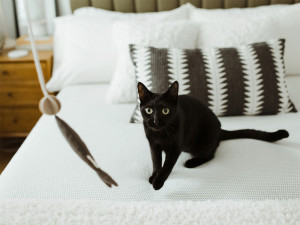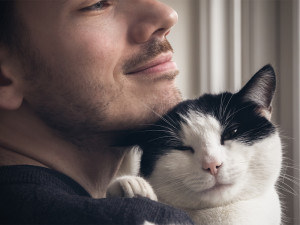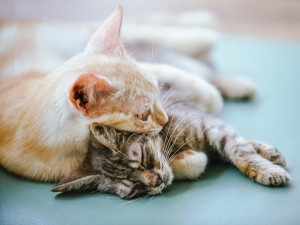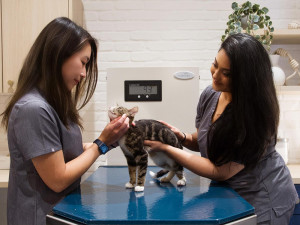How to Reinforce the Bond With Your Cat
A behaviorist’s advice.
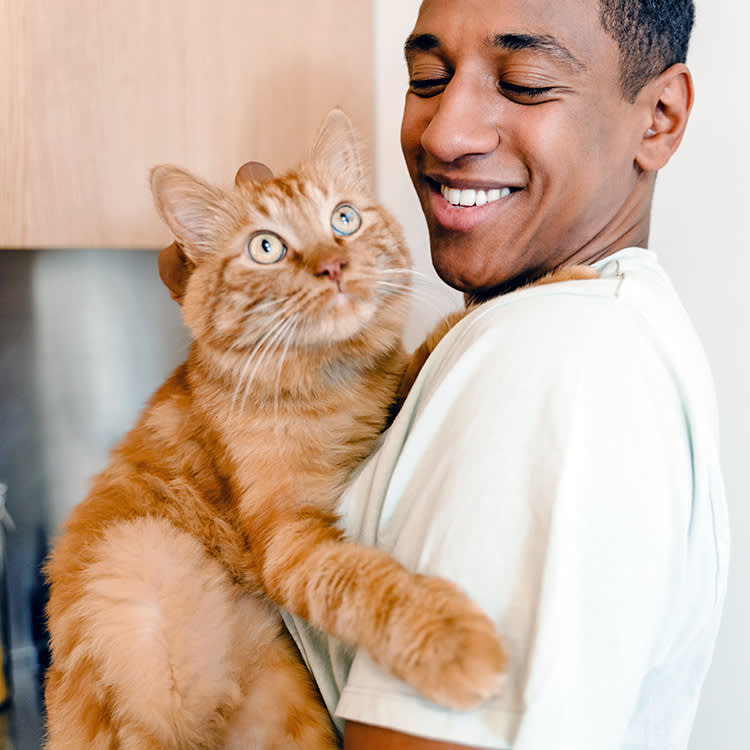
Share Article
In This Article:
What Influences Your Cat’s Bond How Long Does It Take To Bond With a Cat? Ten Ways To Bond With Your Cat How To Get A Cat To Come To You Cat Bonding: What Not To Do
Whether you’re bringing home a new kitten, adopting an adult cat or trying to convince a stray to move in with you, you’re probably thinking up ways to bond. It’s even common to ask yourself, Does my cat like me? How can I tell? Let’s talk about how to encourage and make the most of your bond.
What influences your cat’s bond
Every cat is unique, with their own history, personality, preferences, etc. These can influence how they bond. Some cats long for connection. Others prefer a more solitary life. Some cuddle like there’s no tomorrow. Others may not enjoy being held. You can set the stage for a solid, secure bond with your cat. But it’s also important to respect who they are and what they want.
The best approach is to go into it with no expectations. I know that feels impossible. I’ve had people say that if they can’t turn their cat cuddly into a cuddly kitty, they don’t want them. And that’s a shame. There are so many incredible things to enjoy about cats. Do what you can to create a safe, loving environment. Then let your cat flourish and grow into whomever they’re meant to be.

How long does it take to bond with a cat?
There’s no timeline when you are forming a bond with your cat or kitten. It can take days, months, even years. It’s hard to be patient. But do your best.
Some of my clients have their cats for years without forming a bond. This sometimes happens with former strays or cats with a history of neglect or abuse, who are fearful of people. But when they took steps to improve the relationship and help their cats feel safe, it happened. That bond started to form. In some cases, it was slow-going, and they appreciated every tiny step in the right direction. In other cases, the cats quickly became inseparable from their humans.
Ten ways to bond with your cat
There are many ways you can encourage and strengthen a bond with your cat.
Create a safe environment
It’s not just providing food and water and keeping them safe. Cats are prey animals in the wild. They have a network of needs that help them feel secure, indoors and out. Do a little research. Look at things like keeping outside cats away from doors and windows, spreading resources throughout the home, improving relationships with other pets, etc. A cat who feels safe will be more likely to let their guard down and bond with the family.
Respect their boundaries
Cats have the right to be handled in a way that they enjoy. You may love patting that furry butt or squishing that pudgy belly. Your cat may not appreciate it. Again, they’re individuals. Take the time to get to know what each of your cats enjoys.
Learn cat body language
Cats are masters at body language. It’s worth doing a little reading on the subject. You’re not just looking for big things, like hissing, growling, swatting, and biting. Those are your cat’s way of yelling, “No!” There’s almost always very subtle body language that happens before they get to that point. That’s what you want to look for, so you can stop interactions before your cat gets stressed. It’s your cue to turn the intensity down and respect those boundaries.
Create positive shared experiences
Many cats will seek you out for play and attention. Others may hang back, especially at first. You can encourage more positive interactions by making good things happen when you’re near each other.
Keep your cat’s boundaries and preferences in mind. For nervous cats, maybe you sit across the room and toss a few treats to start. For more comfortable cats, it may be play sessions or snuggling. As long as you aren’t pushing past their comfort zone, each positive interaction helps them build warm and fuzzy feelings about you.
Use positive reinforcement
You can encourage the behaviors you want to see more often by using positive reinforcement. Give treats, pets, play, and other things your cat loves while those things are happening. Reward things like approaching you, coming when called, staying relaxed near you, letting you pet them, staying calm when other pets are near, etc.
Take your time
Don’t rush the process. Your cat’s history with people can play a huge role in how quickly they bond with you. Set the stage with all the ideas we’re discussing here. Then let it unfold as your cat is ready.
Play!
Play is vital for cats — particularly play that replicates hunting. It’s one of the biggest ways to reduce stress, burn energy, and meet your cat’s instinctual needs — all of which make them more open to bonding.
It’s also a perfect positive shared experience. Wand toys are ideal for this play. You can make the lure move like prey so your cat can hunt. How often should you play with your cat? Every day!
Eliminate boredom
A bored cat is a stressed cat. And a stressed cat is less likely to feel secure enough to bond with people. Managing boredom isn’t just about play. Cats need ways to work those brains and use their incredible senses. Food puzzles, hiding treats to find, training, and other brain games greatly improve a cat’s quality of life.
Try clicker training
Clicker training is a great tool for bonding with your cat. You’re hands-on and working together, and it’s a positive experience for your cat because it’s full of treats and rewards. This is really helpful for fearful cats. They can focus on the training so they’re less worried about the person.
Limit stress in the home
I’ve mentioned stress repeatedly because it’s a common issue, making them more nervous, less trusting, and less open to bonding. Manage stress by removing or helping them feel more comfortable with triggers, meeting their instinctual needs, providing plenty of play and enrichment, and giving love to whatever degree they’ll accept it.
If you’re worried there may be something causing serious stress or fear that’s interfering with your bond, consider working with a certified feline behavior consultant.
How to get a cat to come to you
Your cat coming to you for affection is a great sign that you’re establishing a bond. How can you encourage them to come to you, if they aren’t doing it on their own? By giving them a good reason and not forcing them into an interaction they don’t want.
Consider your cat’s comfort level and what they like. For example, if they’re still nervous and keeping their distance, don’t worry about getting them to come to you. They’re not ready. Instead, focus on smaller, less intense interactions, like playing from a distance or gradually getting closer to you for treats.
If your cat is comfortable enough to approach you, it’s time to encourage that behavior. Use things your cat enjoys to show them good things happen when they’re near you. As long as you aren’t pushing past their comfort zone, they’ll quickly learn that coming to you is a great idea. If you use their name or a verbal cue when they approach, they’ll learn.
n to come to you when they hear those words.
Cat bonding: what not to do
It only takes one or two instances where you push too far, and your cat makes a mental note to put their guard up around you. Here are some things to avoid.
Forced interaction
Never force an interaction unless it’s an emergency. A cat isn’t going to put themselves in that position again if it didn’t go well last time.
Touching areas of the body that they don’t like
I know you want to rub that belly. But, if your cat doesn’t like it, resist the urge. The more you respect their boundaries, the more likely they’ll let their guard down. Cats are often sensitive to petting the belly or handling the paws (though doing positive-training work with the paws is helpful so you can trim their nails down the road). For a nervous cat or one you don’t know well yet, it’s best to stick with petting the head and shoulders.
Grabbing them
Cats are smart enough to know that being grabbed and held against their will is dangerous. That’s the kind of thing a prey animal will avoid at all costs. Don’t give them a reason to avoid you by grabbing them in ways they don’t enjoy.
Causing stress or making stress worse
We talked earlier about body language. That’s the best way to tell if your cat is stressed, whether you’re causing that stress with an intense interaction or just trying to interact while they’re stressed about something else. Turn the intensity down on that situation. Let them calm down and reset. Then you’ll have a better chance at a positive interaction with your cat.
When it comes to building and strengthening the bond with your cat or kitten, remember three important things:
They’re individuals with their own likes, dislikes, and fears.
Recognize and respect those differences.
They’ll feel safer and more secure if you avoid pushing past their comfort zone. Make it about respect and love, and you and your cat will be just fine.

LeeAnna Buis, CFTBS, FFCP
LeeAnna Buis has adored cats her entire life and thought she knew them inside out and sideways. But it wasn’t until she worked with a feline behavior consultant that she fully understood how incredible, complicated, and inspiring they really are. She made a career change, starting the certification process to become a behavior consultant right away. She discovered what unique, fascinating, complex creatures cats are and knew this was what she wanted to do with her life — help others on a similar journey to truly knowing, loving, and appreciating their cats.
LeeAnna earned her certification through Animal Behavior Institute, where she received the certified feline training and behavior specialist (CFTBS) designation.
Related articles
Why Does Your Cat Want You to Watch Them Eat
Do they really need an audience?
![two bonded kittens snuggling]()
Why You Should Adopt a “Less Adoptable” Cat
Here’s why bonded kitties, senior cats, and felines with FIV make just as amazing pets as any other.
![dark-haired woman hugging cat that has imprinted on her]()
10 Signs Your Cat Has Imprinted on You
Feeling like you have a little shadow these days? Here’s why that’s happening.
![White and light brown cat laying down with eyes almost closed]()
Study Says “Slow Blinking” at Your Cat Helps You Bond
A team of psychologists at the Universities of Sussex and Portsmouth have discovered the key to building a bond with cats.
![A vet and a vet tech check up on a happy grey kitten in the office]()
How to Find a Vet Who Loves Your Cat Like You Do
I had to kiss a lot of frogs to find the perfect vet. Luckily, veterinarian Dr. Annette Louviere has some tips so you don’t have to, too.
![A German shepherd and cat play affectionately in a bed.]()
Cats vs. Dogs: Behavior, Intelligence, and Care Similarities and Differences
There’s no winning this argument, but here’s what you should know about parenting your new pet.

